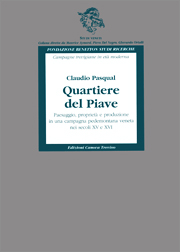
Quartiere del Piave
Paesaggio, proprietà e produzione in una campagna pedemontana veneta nei secoli XV-XVI
by Claudio Pasqual
Edizioni Fondazione Benetton Studi Ricerche-Canova
Treviso 2006
XXVIII-516 pages
an attached plate
25 euros
(series Studi veneti/Campagne trevigiane in età moderna, 10)
[Landscape, ownership and production in the Veneto foothills on the XV-XVI centuries]
Rural society in the Quartiere del Piave, in the foothills of the Dolomites in the Treviso countryside, was remarkably complex in the XVI century.
The city-dwellers’ “race to the country” was much less marked in this marginal area, compared with the larger urban centres; in a general context of small-scale cultivation, the incidence of peasant ownership was greater than elsewhere but the agrarian systems of mixed polycultivation, which were already well-established in family-run farming units engaged in the difficult task of balancing subsistence agriculture and market production, clearly participated in the trading circuits.
Agriculture, however, accounts for only one aspect of the situation. The environment contains other resources, including pasture lands, woods and the river, supporting the important economic activities of live-stock grazing and breeding, and the production of timber and charcoal; in particular, the rural set-up favoured the development of a proto-industrial cottage-based system of wool production. In all these sectors the significant presence of city-based figures, which controlled both production and marketing, demonstrates the close connections between the Quartiere del Piave and the urban world.
Essential for the stability of the system was the existence of vast areas of common land. But at the end of the century the growth process was interrupted by a combination of factors – excessive population increase, huge expansion in agriculture, expropriation of the peasantry and social polarization – and a struggle took place for control of the common land, involving urban rentiers, livestock-owning peasants and unemployed, landless labourers.
Claudio Pasqual studied in Venice under Marino Berengo, who supervised his degree dissertation on Mestre under the Austrians. He then dedicated himself to research, publishing essays in jointly authored works on rural society and the nobility in XIX century Veneto. In 2003, with Mauro Pitteri, he published Mestre tra Ottocento e Novecento [Mestre in the XIX and XX centuries].
Contents
Ringraziamenti, IX
Tavola delle abbreviazioni, XI
Nota archivistica, XII
Nota metrologica, XVIII
Elenco delle tabelle nel testo, XXI
Elenco delle tabelle in appendice, XXV
I. L’area , 3
1. Posizione confini estensione, 3
2. I quadri ambientali, 4
3. L’idrografia, 6
4. Clima pedologia vegetazione, 11
4.1. La montagna, 11
4.2. La collina e le piane, 14
5. La popolazione,17
6. L’ordinamento amministrativo, 19
7. La rete viaria, 20
II. Il paesaggio , 25
1. L’espansione delle colture, 25
2. Il paesaggio delle colture promiscue, 28
2.1. I seminativi, 28
2.2. La piantata, 29
2.3. Il prato arborato vitato e il brolo, 36
3. Il prato, 36
4. Il disegno della campagna, 41
5. In campagna: sopravvivenze di boschi e di incolti, 47
5.1. I boschi, 47
5.2. I pascoli, 52
6. Ai margini: la campagna fuori dalla campagna, 55
6.1. Nell’alveo del Piave, 56
6.2. Sui monti, 57
7. In montagna: i pascoli, i boschi, 59
8. Le forme del popolamento, 67
III. La proprietà fondiaria, 77
1. I distrettuali, 77
2. La proprietà urbana, 81
3. I trevigiani, 89
3.1. I non nobili, 89
3.2. I nobili, 93
4. I titolati della Marca, 95
5. La nobiltà di consiglio, 96
6. I veneziani, 96
7. La proprietà ecclesiastica, 97
8. Gli enti laici, 112
9. Rendita fondiaria e diritti reali, 113
10. I beni comunali, 115
IV. Le risorse collettive, 119
1. Forme e modi d’uso, 119
2. La conflittualità per i comunali, 126
3. La privatizzazione dei comunali, 137
V. I contratti agrari, 145
1. La gestione in economia, 146
2. Tipologie ed evoluzione dei patti agrari, 148
3. La mezzadria, 150
4. La colonìa parziaria, 170
5. L’affitto, 173
5.1. L’affitto misto, 174
5.2. L’affitto in generi, 177
5.3. L’affitto in denaro, 181
6. I patti di miglioria, 184
7. Livelli ed enfiteusi, 193
VI. Le aziende, 199
1. Le dimensioni, 200
2. Il fattore lavoro,205
3. Le scorte vive, 216
4. Il fattore terra, 231
5. La condizione contadina, 239
VII. Produzione e tecniche agricole, 253
1. La coltivazione del campo: le piante erbacee, 253
2. La coltivazione del campo: gli avvicendamenti, 264
3. La coltivazione del campo: lavorazioni, concimazioni, semine, 269
4. La coltivazione del campo: le rese, 274
5. La vite e il vino, 277
6. Alberi da frutta, gelso, olivo, 285
7. Coltura e prodotti del prato, 288
8. La silvicoltura, 291
9. L’attrezzatura, 295
VIII. L’allevamento, 299
1. L’allevamento bovino, 299
2. L’allevamento ovino, 315
3. Equini suini animali da cortile, 336
4. I contratti di affidamento del bestiame, 339
IX. Le attività secondarie , 345
1. Il lanificio, 345
2. Le altre attività tessili, 361
3. Altre “industrie”: carbone vegetale, laterizi, metallurgia, 362
4. Mulini e mole, 367
X. Gli edifici, 373
1. Tipologia e strutture della casa contadina, 373
2. Le abitazioni, 379
3. Gli annessi rustici, 381
4. I materiali da costruzione, 384
5. Le dimore “civili”, 387
6. L’edilizia industriale e artigiana, 388
Appendice, 391
Bibliografia citata, 469
Indice dei nomi e dei luoghi, 485
